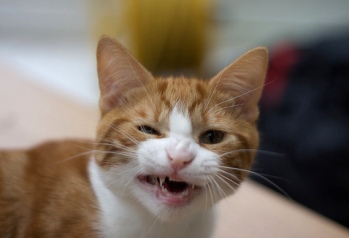What is a Flehmen Response in Cats?
Have you ever noticed your cat wrinkle up his nose like he smells something rancid? He may also lift up his head a bit and even pull back his lips, almost like a cartoon snarl or grimace. If you have seen it, you would know. It’s a distinctive look that catches your attention. Sometimes referred to as making a funny face or pulling a stinky face, this look is a real thing. It’s a biological response with a technical name: it’s called a Flehmen Response or a Flehmen Reaction. Sometimes the verb is shortened and simply called flehming.
Fun fact – Flehmen is a German word that means "lip curl" or "curl the upper lip."
Some pet owners see their cat with a Flehmen Response and mistakenly think he is panting. Unlike dogs, cats don’t pant much. In most cases, cats only pant under extreme circumstances such as when they are in an overly stressful situation, when they are becoming dangerously overheated or when they are in labor.
So when your cat makes that funny face, even though it looks like he is either panting or smelling something bad, it’s really quite the opposite. When your cat has a Flehmen Response, he smells something he likes and he wants to further investigate the odor. That facial position allows him to taste the good smell so he can gather more information about it. Cats have a finely honed sense of smell, but the action is not all located in their noses.
A cat will open his mouth when he smells something good to allow the scent to reach high into the roof of his mouth where a second scenting device is located. You see, there is a small sac located between the hard palate of a cat’s mouth and the septum of his nose called a Vomeronasal Organ or a Jacobson Organ. This specialized sac has a large blood supply, and it’s lined with olfactory receptor cells so it amplifies your cat’s sense of smell. It’s also connected to areas of the cat’s brain that is associated with sexual, social and feeding activities.
see, there is a small sac located between the hard palate of a cat’s mouth and the septum of his nose called a Vomeronasal Organ or a Jacobson Organ. This specialized sac has a large blood supply, and it’s lined with olfactory receptor cells so it amplifies your cat’s sense of smell. It’s also connected to areas of the cat’s brain that is associated with sexual, social and feeding activities.The Vomeronasal Organ is mainly used to analyze pheromones, chemical messengers that are unique to a particular cat. The emission and reception of pheromones is how information is relayed between animals of the same species; it’s a means of communication.
Male cats are more prone to flehming than females, though all cats use this mechanism when they detect an unusual or new scent. It’s more often seen on males, however, because they use it to gauge the reproductive status of female cats, to determine whether a female is in heat, fertile and ovulating by the odor of her urine.
Even though a lot is known about the Flehmen Response, it’s still under investigation. Some experts believe that in addition to measuring a female cat’s reproductive status, felines may use this extra olfactory organ to collect information about the physiological conditions of several different animals, which can help with their predatory activities. This may be one of the reasons people say cats have a sixth sense.
It’s also noted that because cats have a Flehmen Response to vegetal scents such as  catnip, this extra sense may mean or do more than we currently understand. Research is continuing into the Flehmen Response so we can fully identify all of its uses.
catnip, this extra sense may mean or do more than we currently understand. Research is continuing into the Flehmen Response so we can fully identify all of its uses.
Domestic housecats are not the only animals who display a Flehmen Response. Other big cats like lions and tigers do it too, as well as horses, buffalo, snakes, goats, tapirs and more.
Top photo by Bruce Tonge/Flickr Middle photo by Janet 59/Flickr Bottom photo by Tambako the Jaguar/Flickr

